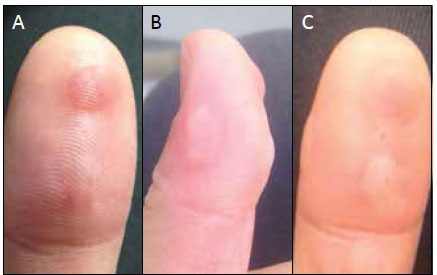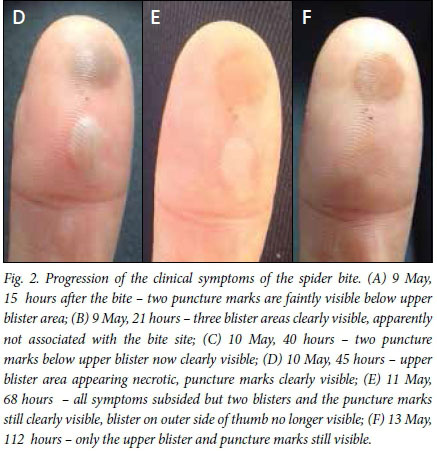Serviços Personalizados
Artigo
Indicadores
Links relacionados
-
 Citado por Google
Citado por Google -
 Similares em Google
Similares em Google
Compartilhar
SAMJ: South African Medical Journal
versão On-line ISSN 2078-5135
versão impressa ISSN 0256-9574
SAMJ, S. Afr. med. j. vol.107 no.7 Pretoria Jul. 2017
http://dx.doi.org/10.7196/samj.2017.v107i7.12422
IN PRACTICE
CASE REPORT
First report of clinical presentation of a bite by a running spider, Philodromus sp. (Araneae: Philodromidae), with recommendations for spider bite management
M CoetzeeI, II; A DippenaarIII; J FreanIV, V; R H HuntI, II
IPhD. Wits Research Institute for Malaria, School of Pathology, Faculty of Health Sciences, University of the Witwatersrand, Johannesburg, South Africa
IIPhD. Centre for Emerging, Zoonotic and Parasitic Diseases, National Institute for Communicable Diseases, Johannesburg, South Africa
IIIPhD. ARC-Plant Protection Research Institute, Pretoria; and Department of Entomology/Zoology, University of Pretoria, South Africa
IVMB BCh, MMed (Path); Wits Research Institute for Malaria, School of Pathology, Faculty of Health Sciences, University of the Witwatersrand, Johannesburg, South Africa
VMB BCh, MMed (Path); Centre for Emerging, Zoonotic and Parasitic Diseases, National Institute for Communicable Diseases, Johannesburg, South Africa
ABSTRACT
This article describes the clinical progression of symptoms over a period of 5 days of a bite inflicted by a Philodromus sp. spider. Commonly known as 'running spiders', these are not considered to be harmful to humans. This report, however, is the first description of an actual bite by a member of this group of spiders showing cytotoxic envenomation. Management of the bites should be as recommended for other cytotoxic spider bites.
The effect of spider bites on humans is known for only a very few spider species in South Africa (SA), relative to the large number of species that occur in southern Africa and that very seldom come into contact with humans.[1] We report on the effects of a bite by a running spider in the genus Philodromus, commonly found in trees, shrubs and grass.
Case report
A 25-year-old woman sustained a spider bite on her left thumb on 8 May 2016 at 18h00, while taking down washing from a washing line in the garden. The bite was described as feeling like an 'electric shock' through the thumb and was extremely painful. Painkillers (tramadol hydrochloride/paracetamol) were taken to alleviate the symptoms.
The spider was caught and later identified as a species of the genus Philodromus (Araneae: Philodromidae), commonly known as running spiders (Fig. 1).

At 09h00 on 9 May, the thumb was still extremely painful and blisters had started to appear (Fig. 2, A). Two faint puncture marks were visible below the first blister, which appeared above the actual site of the bite. At 15h00 on 9 May, three blister areas were clearly visible (Fig. 2, B), not associated with the bite site, and the thumb was still extremely painful.
On 10 May, 40 hours after the bite, two puncture marks were clearly visible below the upper blister but no new blistering had appeared (Fig. 2, C) and the toxic effects had not spread further down the thumb towards the palm. Pain had subsided, but the thumb was sensitive to touch. Later on 10 May, 45 hours after the bite, the upper blister area showed subepithelial haemorrhagic necrosis and the puncture marks were clearly visible (Fig. 2, D). The pain had subsided and painkillers were no longer needed.
On 11 May, 68 hours after the bite, the blister on the outer side of thumb was no longer visible but the puncture marks were still clearly seen. Necrosis of the upper blister had not progressed, and there was no ulceration (Fig. 2, E).
On 13 May, 112 hours after the bite, the upper blister area had started healing and the lower blister was no longer visible, but the puncture marks were still clearly seen (Fig. 2, F).
Case management and treatment was according to best practice as recommended for cytotoxic spider bites, i.e. prevention of secondary infection.[2-4]
Discussion
Philodromid spiders are free-living hunters. They capture their prey by lying in ambush with extended legs. Their movements are erratic, and with their claw tufts and scopulae they are able to move around swiftly on the substrate. They usually run fast and pursue their prey with agility. Most have cryptic coloration blending in with their surroundings. Their colour varies from white to pale cream and from reddish brown to greyish brown, frequently with a mottled appearance or longitudinal bands or chevrons on the abdomen. Their bodies are slightly flattened and clothed with soft recumbent setae. The eight eyes, equal in size, are arranged in two rows (4:4). The legs are directed sideways, with legs I, III and IV almost the same length and leg II usually longer. Their body size can vary from 3 to 16 mm in length.[1] Ten species of the genus Philodromus are known in SA. They are free-living plant dwellers found on the trunks of trees and in low bushes and herbage, where they play an important role as biological control agents feeding on different pest species. They are not commonly found in houses or buildings. This is the first reported bite in SA by a member of the family Philodromidae.
Avoidance of spider bites relies mainly on common sense, awareness and an understanding of their behaviour. The common spiders of medical importance in SA are listed in Table 1, with a summary of their key attributes.[1,5-7]
Acknowledgements. The patient consented to publication of this case report and the thumb photographs.
Author contributions. Analysis of clinical progression was given by JF,MC and RHH. AD identified the spider and gave input on biology and importance. All authors gave substantial input to draft manuscripts and all approved the final version.
Funding. None.
Conflicts of interest. None.
References
1. Dippenaar-Schoeman AS. Field Guide of the Spiders of South Africa. Pretoria: Lapa Publishers, 2014:1-424. [ Links ]
2. Snyman C, Larsen N. Spider bite and its treatment in southern Africa. Occup Health South Afr 2005;11(2):22-26. [ Links ]
3. Müller GJ, Wium CA, Marks CJ, et al. Spider bite in southern Africa: Diagnosis and management. CME 2012;30(10):382-392. [ Links ]
4. Schrire L, Müller GJ, Pantanowitz L. The Diagnosis and Treatment of Envenomation in South Africa. Johannesburg: South African Institute for Medical Research, 1996:1-51. [ Links ]
5. Newlands G, Atkinson P. Review of southern African spiders of medical importance, with notes on the signs and symptoms of envenomation. S Afr Med J 1988;73(2):235-239. [ Links ]
6. Newlands G. Spiders and Scorpions of Southern Africa. Cape Town: Struik, 1987:1-26. [ Links ]
7. Müller GJ. Black and brown spider bites in South Africa: A series of 45 cases. S Afr Med J 1993;83(6):399-405. [ Links ]
 Correspondence:
Correspondence:
M Coetzee
maureen.coetzee@wits.ac.za
Accepted 9 March 2017
















